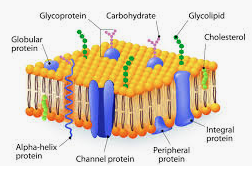MEMBRANE STRUCTURE & FUNCTIONS Online Test and Answers Pdf Download :-
These are very useful & Most Asked Questions in your certification Exam. Read all Online Mock Test Exam Question Bank for Beginners Freshers & Experienced.
1. Cholesterol is somewhat amphipathic due to
A. the single hydroxyl along with the hydrocarbon nature of the remainder of the molecule
B. the long branched hydrocarbon along with the four hydrocarbon rings
C. the five-methyl groups along with the hydrocarbon chain
D. the three six-membered rings along with the single five-membered ring
Answer: A
2. Bacteriorhodopsin
A. absorbs light and pumps protons
B. is an integral membrane protein
C. contains primarily alpha-helical residues
D. all of the above
Answer: D
3. In active transport, the membrane structure that functions is
A. cholesterol
B. integral proteins
C. carbohydrates
D. hydrophobic molecules
Answer: B
4. Cholesterol is essential for normal membrane functions because it
A. plugs up the cardiac arteries of older men
B. cannot be made by higher organisms
C. keeps membranes fluid.
D. spans the thickness of the bilayer
Answer: C
5. The model that is now known to be correct for the structure of biological membrane is
A. Fluid mosaic model
B. Page’s model
C. Lac Operon model
D. Lock and Key model
Answer: A
6. In Fluid mosaic model, the biological membrane can be viewed as
A. two dimensional solutions of oriented lipids and globular proteins
B. three dimensional solutions of oriented lipids and globular proteins
C. two dimensional solutions of oriented lipids and carbohydrate
D. three dimensional solutions of oriented lipids and carbohydrate
Answer: A
7. Membrane lipids are
A. hydrophilic
B. hydrophobic
C. ampiphillic
D. none of these
Answer: A
6. In Fluid mosaic model, the biological membrane can be viewed as
A. two dimensional solutions of oriented lipids and globular proteins
B. three dimensional solutions of oriented lipids and globular proteins
C. two dimensional solutions of oriented lipids and carbohydrate
D. three dimensional solutions of oriented lipids and carbohydrate
Answer: A
7. Membrane lipids are
A. hydrophilic
B. hydrophobic
C. ampiphillic
D. none of these
Answer: A
8. Pinocytosis occurs in
A. all eukaryotic cells
B. all prokaryotic cells
C. mitochondria of all cells
D. none of these
Answer: A
9. Exocytosis is the secretion of proteins
A. out of the cell across the plasma membrane into the extracellular space
B. out of the cell across the plasma membrane into the intracellular space
C. is the uptake of macromolecules from the extracellular space into the cell across the plasma membrane
D. is the uptake of macromolecules from the intracellular space into the cell across the plasma membrane
Answer: A
10. The membrane proteins that catalyze active transport reactions differ from soluble enzymes as
A. they are permanently changed during the reaction
B. the substrates of the reaction are all outside the cell
C. they do not enhance the rates of reaction
D. the products of the reaction move in a specific direction
Answer: D

MEMBRANE STRUCTURE and FUNCTIONS Objective type Questions with Answers
11. The movement of molecules across a membrane by passive transport does not require
A. an input of metabolic energy
B. internal energy
C. vibrational energy
D. none of these
Answer: A
12. Peptidoglycan is a complex consisting of
A. oligo-saccharide and protein
B. polysaccharide and protein
C. mono-saccharide and protein
D. aminoacid and carbohydrate
Answer: A
13. The mesosomes may be the sites of
A. DNA replication and specialized enzymatic reactions
B. RNA replications and specialized enzymatic reactions
C. RNA replications and specialized cyclic reactions
D. None of the above
Answer: A
14. Which of the following is correct?
A. Peroxisomes have a single boundary membrane
B. Peroxisomes contain enzymes that degrade fatty acids and amino acids
C. The byproduct of given reactions in (b) is toxic to cells
D. All of the above
Answer: D
15. The smooth endoplasmic reticulum (SER) is the site of
A. phospholipid synthesis
B. amino acid synthesis
C. carbohydrate synthesis
D. protein synthesis
Answer: A
![MCQs [2024]](https://engineeringinterviewquestions.com/wp-content/uploads/2021/02/Interview-Questions-2.png)